About 30 years ago, osteochondrosis was connected exclusively with people advanced age, whose joints become inactive and injured with each movement. However, times have changed. Today, more and more people change hard physical work for sitting computer work, they are less and less accompanied by food quality, and increasingly encounter osteochondrose of Hotel Cervical. No wonder of osteochondrose calls the "century disease", and almost every person who reached 25 encounters the symptoms of this disease.

This is a sub-raid disease, starting from unpleasant neck, leads to severe consequences in the form of hearing and vision, as well as the worsening of memory until it can worsen. Therefore, each person should know the causes of osteochondrose and contact a doctor in the event of an unpleasant symptoms in the event of an unpleasant symptoms. We'll talk about them in this article.
Causes of osteochondrose Regions of the Grlić registrar
Paradoxically, all our problems with a cervical spine start in early childhood, or better said in primary school, where the child aggravates development and scoliosis. At this point, the maintenance system of the spine boss was injured, especially the most important and vulnerable department - cervix. Another key factor in the osteochondrose of the cervical region, which began its beginning in a distant childhood, is especially physical preparation, especially the weakness of spinal muscles and thus - the correlated muscle corset designed to support the spine.
These are the two most important causes of the disease. Everyone else with a large load fall on a weakened spine, causing the development of disease in pretty young and healthy people. First of all, they include a sitting lifestyle and lack of physical activity, especially, which is associated with long stay in one position. This is the most characteristic for drivers and office workers, replacing on the computer. All this complements excess body weight, which seriously increases the load on the spine.
Other causes of osteochondrose of the cervical spine, should be distinguished:
- portable spine injuries;
- Metabolic offense;
- hereditary predisposition;
- Great physical effort;
- constant nerve tension and stress;
- Anomalies in the development of the neck of the spine;
- Bad habits (holding a telephone tube with your ear and shoulder).
Osteochondrose development process
These harmful factors ultimately lead to the increase in the load on the spine of the cervix. When you try to compensate for the excess load of the neck muscles, their spasm appears, leading to blood circulation violation in this area and reducing metabolic processes. All this is converted into the development of degenerative processes in the spine. First of all, the vertebrae start to become thinner and approach, squeezing their content (fibrous ring) outside the spine. Such protrusion in the language of the doctor is called a protrusion.
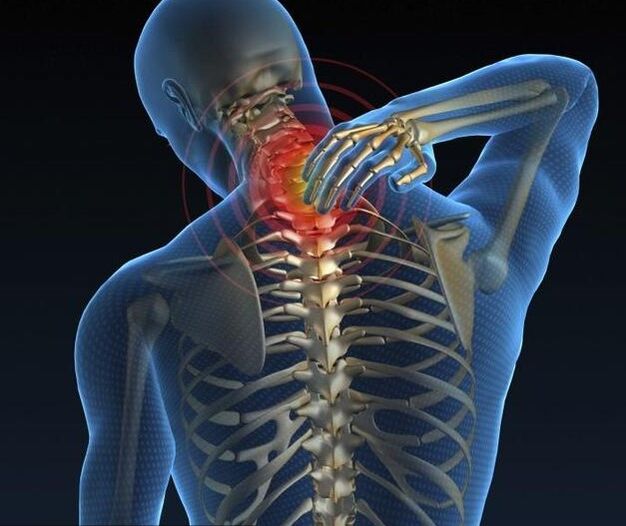
In the case of protrusion, the fibrous ring still retains its integrity, but the protrusion is already compressed by blood vessels and nerves that pass along the spinal column and food brain. Moreover, converging and deforming vertebrae begins to squeeze the roots of peripheral nerves, which leads to the development of such a "radicular syndrome", which is manifested by strong back and neck pain. If you do not identify the problem (which will be eloquent symptoms) and do not start to treat osteochondrose, the fibrous ring will appear and your fiber ring will appear and the fiber ring will appear, and the vertebral kill will appear. In this case, serious brain nutrition problems will appear.
Symptoms of cervical osteochondrose
In their development, the disease passes several phases, each of which has characteristic characteristics and symptoms. It should be noted here that the osteochondrosis of the throat spine differs from degenerative changes in other parts of the spine. The distances between vertebrals here are minimal, and even small degenerative changes cause unpleasant symptoms and lead to different complications.
Osteochondrosis 1. degrees.This is a prayer phase of disease development, in which the patient experiences slight pain and discomfort during head turns, as well as tension and fast fatigue in the neck and back with a long finding in one position (often in sitting). At this stage, osteochondrosis is treated perfectly with changing lifestyle, dietary corrections and regular physical exercises.
Osteochondrosis of II degree.In this stage, instability appears between the vertebral in the neck. In this case, the person is facing intense pain, which are given to the shoulder, neck or hands. During the tendency or turning of the head, the pain increases significantly, because due to the reduction of the distance between vertebrae, the nerve endings begin to violate. The patient starts quickly tired, his performance is reduced, distraction, forgotting and headache appears.
Osteochondrosis III degree.At the beginning of the third phase of the disease, pain in the back and neck becomes even stronger, the mobility of the door is significantly reduced, and when the spinal cramp can be heard. At night, the patient begins to go with stiff fingers (primarily with small fingers and a ring), which is why a person wakes up several times in the night. During the day, such patients have an unpleasant seriousness in their hands. And even a short conversation on the phone, in which a person is forced to hold a cell phone near the ear, turns into unpleasant tuning and stiffness in his fingers. All this indicates an increase in the protrusion, and the eventual emergence in the Cervical region.
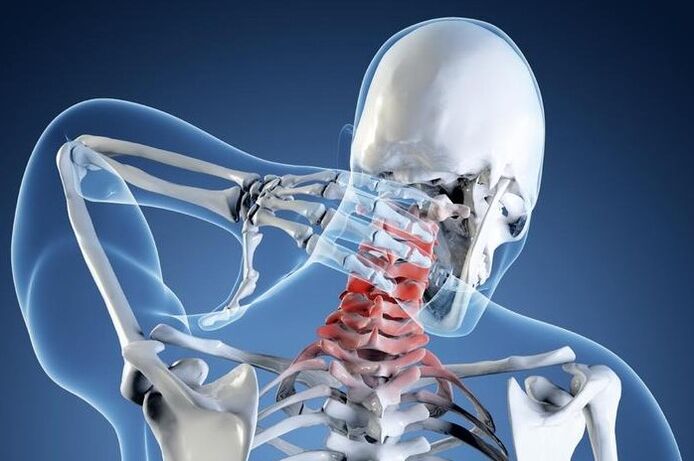
Osteochondrosis IV degree.In the last phase of disease, vertebrates were destroyed, which stop implementing their functions and start replacing them with connective tissue. The patient in this country can observe the violation of the movement coordination, the noise and pulsation in the ears are crazy, headaches are improved, the sharpness of sight and hearing is reduced. In some cases, tongue stiffness can be observed.
It should be said that due to the transmission of blood vessels, the blood in the brain is disturbed. Therefore, the patient has neurotic disorders such as insomnia, nervousness, irritability and indignation, frequent changes in mood and inability to concentrate. Outbreaks of anger or fear may occasionally occur, attack the longing and depression.
In the later stages of osteochondrose development, the strongest blood vessel cramps may lead to "flies" in front of their eyes, a sense of instability on a hard, flat surface, nausea, vomiting.
Diagnosis of the disease
In order to identify the cause of pathology, the patient describes the unpleasant symptoms of his condition. After hearing the patient, the specialist sends it to one of the following research methods.
Radiography.Currently, this diagnostic method is considered uninformative, especially in the last phases of disease development.
Ultrasonic duplex scan.This method is used in cases where the specialist involves violating blood flow in the arteries that give brains on food. The study shows blood flow and determines whether there are obstacles on its way.
CT (computer tomography).This method is informative in relation to radiography, because it does not only reveal the problem, but allows you to determine the presence and size of Hernia, although with difficulties.
MRI (magnetic resonance.Most informative methods for the diagnosis of osteochondrose, which allows you to carry out bones, the presence of a kile, and even the direction of their development.
Healing osteochondrose
We will immediately say that they will fight such a serious problem as a osteochondrose of the cervical region, you should turn to neurologists. True, if the clinic has a doctor in the vertebrae, it's better to contact him first. You can only treat osteochondrose. The complex of used methods includes medicinal therapy, wire zone massage, exercise zone, physiotherapy methods, as well as proper nutrition. Only a combination of all these methods will help to deal with the disease and normalize the patient's well-being.
Help with strong pain
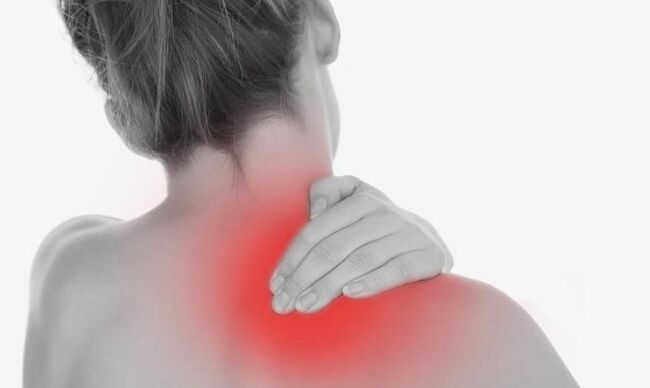
In case of strong pain syndrome, doctors recommend taking analgesics. When these funds stop making a relief, you can switch to nonsteroidal anti-inflammatory medications.
In general terms, medicine therapy includes the following funds:
- NSAIDS (Non-steroidal anti-inflammatory drugs). These products remove pain, mitigate swelling and carry with inflammation of nerve roots.
- Chondroprotectors. Such medications perfectly restore damaged cartilage tissues.
- B Vitamins B. They are needed to improve metabolic processes in nerve tissues.
- Musorelaxans. The effect of these medications is focused on reducing muscle cramps.
- Preparations that improve the rheological properties of blood. Thanks to such funds, the flow of oxygen and nutrients to brain and nerve endings improve.
Here it should be noted that it is possible to achieve the tangible effect in the fight against osteochondrose using fats and tablets only if medicinal treatment combines with other therapy methods. Otherwise, medications will only give a temporary effect.
Many experts tend to deal with osteochondrose with injections to quickly affect nerve endings and save the patient from possible side effects when taking tablets. However, vitamins are best recorded orally, as vitamins are well absorbed with any method of taking, but injections with them can be painful.
Physiotherapy methods of treatment
Medicinal treatment must be combined with physiotherapy methods of therapy. They are considered most effective in this disease:
- Electrophoresis (in combination with drugs). Medications in this case penetrate damaged vertebral spins under the influence of electricity.
- Ultrasound. This exposure method allows you to mitigate the inflammatory process, calm the pain and improve the metabolic processes in the tissues.
- Magnetotherapy. This type of physiotherapy relieves swelling and eliminates pain.
- Laser therapy. This is a great method of combating inflammatory processes, which also improves blood circulation.
Osteochondrose diet
The renovation of the affected vertebrae includes a special diet that normalizes the metabolic processes in the body, prevents salt deposition, nurtures and restores the cartilage tissue, and also strengthens the ligaments between vertebral.
To achieve this, above all, the patient's diet should be excluded:
- Alcoholic beverages;
- thick and fried dishes;
- Sharp and too salty dishes;
- Jake soups;
- Weaknesses and sdoba;
- Strong tea and coffee;
- pickles and marinances;
- Preserved products.
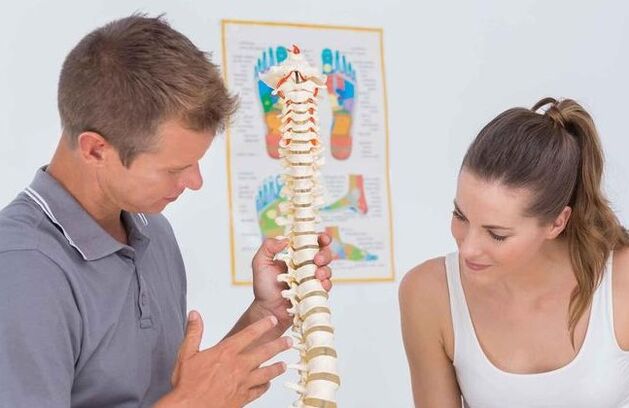
The patient's diet with osteochondrose should consist of the following food:
- Low -phate meat and fish;
- Milk, cottage and kefir;
- butter (in small quantities);
- Cereals and soups from entire cereals;
- jelly, spill of fish or meat;
- vegetables, fruits and berries;
- Juices, fruit drinks, wants compotes.
During the localization of osteochondrose in the region of the parishers, it is important to adhere to drinking regime, drinking at least 1, 5 liters of water a day. If there is an excess weight, then you should think about how to get rid of an extra pounds that provide an additional load on your spine. It is advisable to switch to strength 5 times a day in small portions.
At the same time, as can be seen from the list of products allowed, the basis of food should be low vegetarian soups, boiled no -fat meat, fish, sea food, unswapitious vegetables and fruits.
Approximately the day for the day will look as follows:
- Breakfast: Cottage, a pair of apples, sugar-free tea;
- Lunch: a roasted pear, a little oatmeal;
- Lunch: Vegetarian borsch, boiled chicken with herbal salad;
- Afternoon snacks: Dry cookies and fruit fruit;
- Dinner: Baked fish with vegetables and tea without sugar.
Exercise therapy for osteochondrose
Physical education gives incredible results in the treatment of osteochondrose, it is true that it is involved in the gymnastics for cervix only during the recovery period. It is important here that in the massage process or gymnastics, the patient does not experience discomfort and pain.
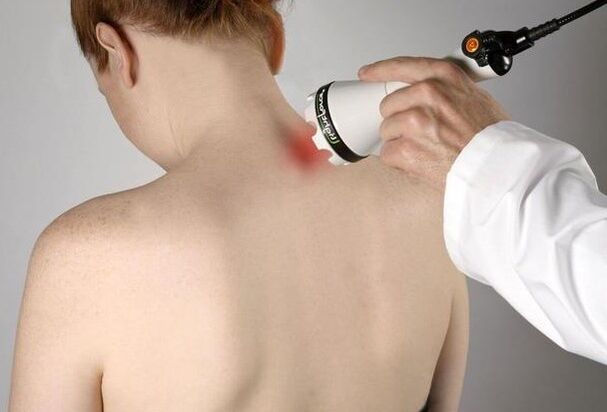
Here are a few most efficient gymnastic exercises aimed at strengthening the uterine muscles and improving blood circulation in this area.
Exercise 1 1Lying on the stomach and resting his hands on the floor, slowly lift your head and torso, so that the back stays straight. Keep in this position for 1 minute, then return to the starting position. The element is repeated 2-3 times.
Procedure number 2Lying down on the stomach and reach out with the body, raise your head a little and start turning it first, trying to touch the eye, then on the left. Perform 6 turns in each direction.
Exercise number 3Sitting on the floor, on inspiration, tilt forward, trying to reach the chin to the chest, and to exhale, return to the starting position and throw your head back. Repeat the element 10-15 times.
Procedure number 4Attach your palms to the forehead and try pressing your head with effort. At the same time, the door strain of the neck, resist your hands, preventing the head from rejecting. Keep pressure 20-30 seconds then lower your hands and relax. Repeat the element 2-3 times, then repeat the exercise in the opposite direction, giving up the grips on the back of the head.
Exercise 5 5Start slowly turn your head to the right and on the left, trying to look behind your back. Make 10 turns on each side. Good health!














